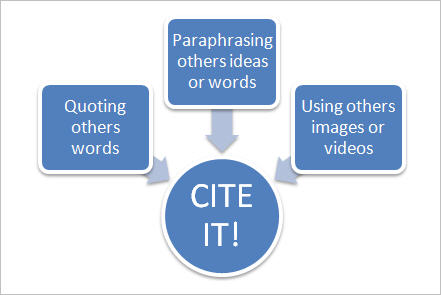
The Library has a copy of the MLA Handbook, 9th edition that can be used in the library

There are many reasons why it is important to cite the resources that you consult when researching a paper. The most important of these are:
Copyright grants a set of exclusive rights to creators, which means that no one else can copy, distribute, perform, adapt or otherwise use the work in violation of those exclusive rights. This gives creators the means to control the use of their works by others, thereby incentivizing them to create new works in the first place.
The person who controls the rights, however, may not always be the author. It is important to understand who controls the exclusive rights granted by copyright in order to understand who has authority to grant permissions to others to reuse the work.
"To represent oneself as the author of some work that is in fact the work of someone else is to plagiarize. Plagiarism may include the 'passing off' of the form of the work—for example, the exact words of a piece of writing—or the intellectual content, or both" (Pickering).
Plagiarizing, whether intentional or by accident, is a violation of the Intellectual Property Policy in the Student Handbook page 60 .
Learn More about Plagiarism
Pickering, John W. "Plagiarism." Encyclopedia of Social Problems, Vincent N. Parrillo, Sage Publications, 1st edition, 2008. Credo Reference,
https://go.openathens.net/redirector/chattahoocheetech.edu?url=https%3A%2F%2Fsearch.credoreference.com%2Fcontent%2Ftopic%2Fplagiarism%3FinstitutionId%3D3554. Accessed 22 Oct. 2019.
Plagiarism: What is it and how you avoid it
Remember, if you use someone else's ideas and/or quote their words you must give them credit.
"The in-text citation in your text makes clear to your reader what you took from a source and where in the source you found the information" (Bullock 112) .
"A typical in-text citation is composed of the element that comes first in the entry in the works-cited list (usually the author's last name) and a page number" (MLA Handbook 54) . Each in-text citation will take you to a more detailed citation on your Works Cited page. Once you have your citations done on the Works Cited page at the end of your paper you will be able to determine more clearly what to put in your in-text citation.
EXAMPLES:
Author mentioned directly in your paper as a signal phrase:
According to Naomi Baron, reading is "just half of literacy. The other half is writing"(194).
Direct Quotation:
Reading is "just half of literacy. The other half is writing" (Baron 194).
Author Unknown:
When an entry on the Works Cited page begins with the title of the work because the author is unknown, use the work's title or a shortened version of the title in the parentheses.
Example: A powerful editorial in last week's paper asserts that healthy liver donor Mike Hurewitz died because of "frightening" faulty postoperative care ("Every Patient's Nightmare" 27).
Sources:
Bullock, Richard et al. The Little Seagull Handbook with Exercises. W.W. Norton, 2014, pp.112, 115.
MLA Handbook Eighth Edition. Modern Language Association of America, 2016, p.54.
Paraphrasing uses the key ideas from other sources, but these ideas are put in your own words. Because the idea is the source's, you still should cite the source with a proper citation.
For more information: